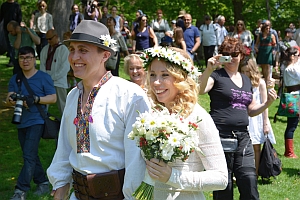Comments?
For the basics, see
- Website & Privacy Policies
- How To Get Involved
- The Role of the Park
Search options:
Department Site Map
Custodians:
 May-June 2015
May-June 2015
Dufferin Grove Park Newsletter
Comments? editor@dufferinpark.ca
May / June 2015 Newsletter
This newsletter is put out by CELOS, the Centre for Local Research into Public Space. Since 2000, when this little organization began at Dufferin Grove Park, we’ve been doing what we call “theoretical and practical research” into what makes public spaces – like parks – more hospitable and more lively. We’ve been researching what works and what doesn’t, and we’ve documented a lot of what we’ve seen and done, in the fifteen years of this newsletter and on our websites. The printing of the paper version of the Dufferin Grove newsletter is currently supported by the GH Wood Foundation.
What works: the cob courtyard café
The cob courtyard/café has reached its tenth year. It was community-built, with the help of more than 500 pairs of hands of all ages, over the course of the long spring/summer of 2005 – under the leadership of park friend Georgie Donais. Park program staff gave much practical support, including providing snacks for volunteer builders. City of Toronto Parks Tech Services staff did all the wiring and the plumbing. The wooden/tile counter and cabinets were built by Silvie Varone and Simon Evans.
Over the years, the counter gradually began to bio-degrade bit by bit in the weather, but the cob wall is in very good shape. There has been maintenance all along, especially for the shingles protecting the top of the wall. This is the year for a bigger reno, thanks to the City of Toronto park’s tech services staff: a new counter, new sinks, new cabinetry and plumbing.
What works: a public enactment of a Ukrainian village wedding in the park
Mark Marczyk and Marichka Kudriavtseva met and fell in love during the Euromaidan protests in Kiev, Ukraine, when Mark was visiting there with the Lemon Bucket Orkestra. When Marichka and Mark decided to marry, they wanted to have their wedding in a public space, because that’s how Ukrainian weddings used to be performed. “That’s the way weddings were traditionally done. They weren’t in a hall or a private castle or anything. They were done in the streets,” Mark said. So they invited people via Facebook, and hundreds of Ukrainians and non-Ukrainians came to Dufferin Grove on May 17. There was music, and dancing, and vows exchanged. There was even a wedding parade through a very surprised Dufferin Mall. All of this, park, parade, and mall, was without benefit of official permission. Motto: “just do it.”
Editorial: Why there are no more listings of city-run park programs in this newsletter or on the dufferinpark.ca website:
When the city's Recreation Management took over the running of Dufferin Grove in 2011, a lot of things began to change. Gradually, the park was brought into line, or "harmonized," with the way the rest of the city runs. Park staff were told by management that they must stick to their own strictly limited tasks, so one often began to hear "it's not my job." Experienced staff from former times were prevented from using their skills to shop for supplies, to address crises collaboratively, or to arrange their work according to need rather than according to pre-set schedules. Discouraged by this dumbing-down, some of the long-term staff began to leave. Transparency about costs, and about work problems, disappeared. Silos increased: for example, a separate unit of centrally-administered staff was parachuted in to run the park's wading pool. Those wading pool staff were told not to engage with the park's other program staff.
City management has long regarded the newsletter and also the dufferinpark.ca website as having very limited legitimacy as a forum for park news, since neither are run by the city. Even so, the newsletter and the website have been the main source for news of park events. And until mid-February 2015, our group (CELOS) operated the park's internet connection for all park business. Staff used various gmail accounts, because the park's official city internet connection, installed in 2014, was never activated.
By mid-February, Recreation Management's reluctance to collaborate with CELOS made it obvious that it was time for the newsletter and the website to stop being a news forum for city-run programs. We withdrew the CELOS web connection, and asked Recreation Management to activate the city's internet connection for their staff. This has been done. However, park programs and schedules (including for the campfires) are not publicized by the city. That’s a shame. Meantime, CELOS will continue to be involved in Dufferin Grove Park, focusing on long-time and new neighbourhood-based initiatives.
What doesn’t work: the City of Toronto wading pool regime
CELOS has made a slide show about why the city’s wading pool approach has sharply reduced wading pool use all over the city. It’s on the dufferinpark.ca website and a copy of the show will be put up on the fence beside the sand pit in June. The slide show is called
What works: flowering trees planted at the park by park friends
The City Parks Department has a memorial tree-planting service which charges donours $700 a tree. Dufferin Grove has a few such memorial trees; they’re very nice. But most of the donated trees came more informally, and cheaper, planted by park friends over the years.
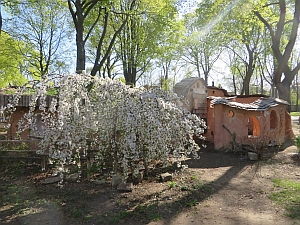
weeping cherry: memorial for Emma Frankford
Some of the informally donated trees flower in the spring. Here’s how they came to be in the park. During the 1930’s, Dufferin Grove Park was known all over the city as a showplace for trees and flowers. But by 1990, the last few flowerbeds had been grassed over by the city (too expensive to maintain) and very few trees were being planted. Then in 1993, a new garden bed was dug by park friends, to be followed by fourteen more such garden beds before 2000. In 1996, a neighbour brought over a little serviceberry bush and planted it across from the first bake oven, at the southern tip of a newly planted vegetable garden. The following winter the Zamboni ran over the bush while dumping snow. In spring the bush came back, a bit bedraggled but still growing. The next winter the rink’s program staff put temporary barrier fences around the serviceberry, but the Zamboni driver moved the fences and ran over the bush again. When summer came again, a split-rail fence was put up around the garden, and from then on the Zamboni dumped the snow elsewhere in winter. The serviceberry made a brave comeback, and now it’s the height of a small tree. Kids balance on the split-rail fence and eat the berries (they’re close to blueberries in colour and taste).
The next flowering tree planted was a Bing cherry tree, bought with snack bar funds, and community-planted with permission from the city staff. When it turned out that every Bing cherry tree needs a mate, park friends planted another one nearby. But by mistake we bought a sour cherry tree. Even though it was the wrong tree, it grew well, so we kept it. The next year we planted a real Bing cherry tree. All three trees now provide cherries to raccoons, to birds, to tree-climbing kids and – if they’re quick – to the Friday Night Supper cooks looking to make some pies.
Next came two wild plum trees donated by former city councillor Mario Silva, and planted by park friend and long-time garden advisor/helper Gene Threndyle. Gene also planted some elderberry bushes which grew tall and provided more fruit for birds and for pies. Then in 2006 the family of Emma Frankford planted the dwarf weeping cherry tree in Emma’s memory, beside the cob courtyard café. It’s always the first flowering tree to bloom in the park.
More recently, John Ota added two pink-flowering Japanese cherry trees near the rink, in honour of the Japanese-Canadians who grew up in this area (mainly on Gladstone), and who loved the park as children. All these trees have become part of the spring story of the park. In the years since the first community plantings, city staff have planted lots of new trees as well, including ones that are covered with flowers in the spring. So many trees! A win-win.
What doesn’t work: the rink clubhouse reno and other money sinks
The rink house was rebuilt in 1993, so that makes it 22 years old. Someone, somewhere, decided last winter that it needs to be renovated again. Rumour says that the budget for doing this is $250,000. An architect was hired and began design work. More recently, the onsite staff were invited to say what they might like to see. Eventually there will be a public meeting, presumably with sketches of the architect’s plans.
This is the second major renovation in the park in the last 6 years. The first was the wading pool, which got new plumbing, a new layer of surfacing that made it very slippery, and some stone benches and pavers where sand used to be (now covered by sand again). Only the new plumbing was actually needed, to replace the rusting pipes, and it was not even in the original plans – it was added when the program staff asked for it. In addition, the city councillor of the time, Adam Giambrone, managed to pull some strings so that the paving of the centre north/south path was tacked on to the wading pool project – a great boon for park users in place of the rough mud track that was there before 2009.
The wading pool renovation cost $227,000, including $13,500 for an architect and $15,000 for a project management fee.
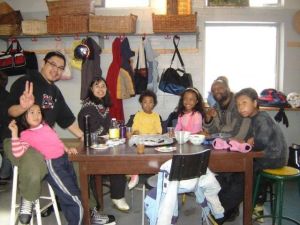
skater picnic in the rink house
And now it seems the rink house is getting its turn. In 1993, it was rebuilt as a three-months-a-year facility, with a cluster of little rooms and no eye-level windows. Over a few years, park friends worked with city staff to alter the building for year-round use, adapting an unnecessary staff office, a garage alcove, and a surplus slop room as kitchens and a café. Some unnecessary walls were removed, more windows were put in, and Home Depot donated better lighting. The changes cost about $51,000 in total, and set the stage for many new activities.
The rink house changes showed that parks can be made lively without spending a lot of money. Dufferin Grove became an early example of a formula that’s being used in many cities which are not as rich as Toronto: “lighter, quicker, cheaper.”
But that formula seems to be of limited interest to Parks capital projects management, and of even less interest to our politicians. The Parks, Forestry and Recreation budget has been hugely increased over the last 10 years, and this year it’s almost $610 million (operating + capital). With all that money, the rink house renovation will most likely be followed next by a new playground. The wooden playground was proposed for replacement in 2006, but at that time park friends persuaded the councillor to preserve what exists now. Everywhere else in the city, playground funds are flowing – with plans for spending $42 million citywide on replacements or additions by 2018. Much of the money for such projects is borrowed, but servicing that debt comes out of the operating budget (borrowing not allowed). Paying interest on capital loans means less to spend on staffing the programs – or hiking the user fees again.
In such a climate of spending, how long can Dufferin Grove hold on to being a cheap park, where many activities have no extra fee, and where people friendly to the park can have an influence on city hall?
What works: the park as a source for local (and some wild) foods
Recently, a surprising number of cooks in famous restaurants have begun to cook with foraged foods, including weeds, found in the restaurants’ own hinterland. Dufferin Grove seems to be ahead of the curve. The tree nursery just south of the field house has lots of stinging nettle, planted years ago – great for making nettle soup and nettle pasta. (Foragers: wear gloves and long pants when picking!) Plantain grows all over the pesticide-free park, tasty in salads and cooked greens. Linden flowers can be gathered from the trees to make tea and cooling summer drinks. Soon the cherries near the rink house will ripen, also the serviceberries by the oven and down in the hollow, and after them the elderberries, and the gooseberries by the cob courtyard. So many opportunities for foragers! Plus, the farmers’ market is selling wild leeks and fiddleheads and lamb’s quarters, soon to be followed by wild mushrooms, and elderberry jam. Foragers and market shoppers, get out your bags.
What doesn’t work: the annual park cleanup day….
…because the spring cleanup work is done by park staff. So there is very little left for a neighbourhood volunteer cleanup crew to do. Every year in early April the seasonal parks staff (CUPE Local 416) are recalled from their winter layoffs and they start their work, usually beginning with the most heavily-used parks, like Dufferin Grove and other regional city parks.
This year's parks/forestry/rec operations budget (i.e. not counting any new capital projects) is $436 million, so -- happily -- there is enough tax money to pay the city staff to maintain the parks. After the intensive spring cleanup, park staff clean twice a week off-season and at least once a day -- at very busy parks like DG -- during peak season.
What works: no-fee community use of the rink pad when the ice is gone
On the hockey rink pad, there’s alternating ball hockey and bike polo. On the pleasure-skating rink pad, there’s an unofficial skateboard setup, with BMX bikes sometimes joining in. Most of the equipment is built by skateboarders, who have crowd-sourced to pay for materials, as well getting donations from Converse, from local skate shops – and from funders (through CELOS). The older skateboarders build and maintain the structures (with some repair hours assigned to a city worker as well). The neighbourhood youth in their mid-teens get the free ride, and passersby get the scary thrill of watching skaters apparently breaking the laws of gravity. Injuries are surprisingly rare, far less common than in soccer, for example.
What doesn’t work as well as it used to: campfires
The campfires at Dufferin Grove started up slowly, about twenty-one years ago. They were neighbourhood gatherings, sometimes organized by park staff but more just by small groups of park friends who wanted to get together for a birthday, a graduation, a going-away or coming-home celebration, or just to enjoy each other’s company, outdoors under the open sky. The result was a friendlier, safer park in the evenings.
As people noticed the campfires, walking through the park, word got out. People from other parts of the city started calling to book a campfire date. For a while it looked like campfires would become established in other neighbourhoods, allowing people to gather in the same way in their own local parks. But there were many blocks and objections, and it seems as if people found it easier to just use what works already, instead of pushing against the obstacles in their own area. In the last five years or so, the campfires in this park have become so numerous that just booking them and monitoring them takes up lots of staff time. Last year there were over 500 campfires. People email the staff “dear sir or madam,” asking to reserve a “camping spot for a bonfire” or a BBQ. A half-hour orientation session is required, but people coming to the sessions are often distracted, trying to fit another meeting into a busy schedule. So the campfire rules are sometimes forgotten, and the fires begin without the required pails of water, and the shovel and bucket of sand. Sometimes they get noisy and there’s occasional open beer drinking (alcohol in parks is illegal). There are even arguments with the park staff from time to time, by people insisting that they don’t need to book a spot, they can just take it, it’s their right as Torontonians to do what they want in public space, why are staff being so pushy, why can’t they give “better customer service.”
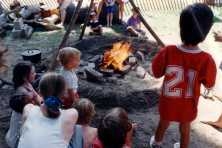
campfire 1994
That’s a long way from the friendly local campfires nearer the beginning, when passersby could enjoy the glow of the fire and wave to their marshmallow-roasting neighbours. And worse, people from the neighbourhood, from local schools, from local daycares or scout groups, find that if they don’t book months ahead, they can’t get a campfire spot because all the times are booked already.
There are still plenty of good campfires, they still do put “eyes on the park” on dark evenings, many of them still feel local and friendly. But this program is suffering a bit from its own success. If many other parks opened up in the same way, with staff support and minimal fees, the problem would go away. What are the chances?
Save the date: on June 20 at 6 pm, a special Saturday night supper for the park ovens, and to remember Dan DeMatteis

Dan
This year the park’s bigger community bake-oven turned 20, and the smaller oven turned 15. Both of them have held up well with so much use, but by now they both need some repairs. This provides an occasion to have an extra supper – to raise some repair funds, and to celebrate one of the first cooks who started the suppers, in 2003. This was Dan DeMatteis, who began his cooking career at the park – before going on to work at Jamie Kennedy’s and other Toronto restaurants. Dan died suddenly of an aneurysm in 2012, and is much missed by former Dufferin Grove colleagues as well as by cooks and friends across the city.
Two former park staff who cooked with Dan in the early days of the suppers have agreed to come back and cook this June 20th dinner: Lea Ambros (still a local park friend) and Anna Bekerman (now living in Arizona). Others of Dan’s friends will be there to help with chopping, serving and washing dishes (more volunteers welcome, kids included!). And there’s another reason to celebrate that day: the GH Wood Foundation has given funds to CELOS to build more picnic tables and benches for a comfortable seating area beside the big oven. We were inspired by an arrangement of tables, benches, and planters built by James Davis for a Foodshare roof garden on top of a school in east Toronto. James called the space he created “Dan’s Table” (also after Dan DeMatteis) and he was kind enough to share his blueprints. On June 20, the new sitting area will be ready for use. If it rains, the big market tents will be up to keep the eaters dry and remind the old-timers of the fun they once had eating in the rain during the park’s Cooking Fire Theatre festival.
What works: kids climbing in the park
These days there’s lots of debate about playground safety: have the new, low-to-the-ground playground designs gone too far in bubble-wrapping kids? It seems that kids need to take risks, and many child advocates say it’s important to let them. So Dufferin Grove playground has kept the long swings, and the monkey bars. The playhouse roofs were not intended for climbing, but many kids do get up there, and sit there surveying the world. In the 1980s, many of the trees had their lower branches cut off by staff so the kids couldn’t climb them, but the more recently planted cherry trees are easy to get up on, and to go high. The top of the shed roof beside the wading pool is a place for kids playing cards without being bothered by younger siblings. And the new, higher storage sheds by the basketball court are a real challenge – older kids can climb up by the chain link fence and lunge across to the roof, and when they want to get back down they can use the nearby basketball pole to slide down like firefighters. Adults may want to turn away so they don’t get anxious watching, but at Dufferin Grove, the kids are developing nicely.
Randy Heasman: an appreciation
Back in December of 2001, all of the city’s outdoor rink pads were still closing every day at 9 pm. Dufferin Rink friends thought that was a shame – the rink season is so short, the moon is so bright in those cold winter skies, shinny hockey is so well-loved. There was no money for staffing, but a rink friend had the keys, so some of us started keeping the rink open until 11 pm when we had time. Word got around. Soon, rink friend Randy Heasman came with a proposal: he wanted to have a regular slot for an “over-35” neighbourhood shinny game, to get some of the older guys back into playing. So we made sure the rink was always available for them on Thursdays after 9pm. Randy knew a lot of people, and the program was a success right from the beginning. A neighbourhood women’s hockey group showed up next. Then we put in a couple of regular nights for youth drop-in, with an anonymous donour giving the city $769 to fund staffing.
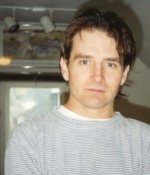
Extended hours at Dufferin Grove caught on, and after a few years the city decided to staff them every night. Many other rinks began to stay open later too. On the part of the local shinny players, though, there was some well-grounded anxiety – that a new one-size-fits-all citywide permit system would take away after-9pm community shinny times and replace them with centrally-booked permits. That was the city’s plan. So Randy’s Thursday night group, for example, might be assigned a rink slot in Scarborough, while a group from Etobicoke would have to travel to Dufferin Rink on that night.
Randy said, don’t despair. In his friendly and determined way, he lobbied to let the “local-older-guys” and the other neighbourhood-based groups keep their games at Dufferin Rink. Randy's group is now in its fifteenth year, and some of those over-35 guys are now over 55.
Randy died in May, of non-Hodgkin’s Lymphoma, at age 58. His memorial gathering was overflowing, and it included many shinny hockey players, male and female.
Recently, the NHL Players’ Association made a donation of 20 new sets of shinny equipment (skates, sticks, gloves and helmets) for kids and youth, to CELOS. The equipment will be used at Dufferin Rink and will also be loaned out for shinny hockey to other rinks across the city. The donation came partly as a result of an enthusiastic letter of support to the Players’ Association from Randy, written a year ago. It was just one of the innumerable small gifts that he leaves behind, because of his steadfast enthusiasm for sport, and for people.
Credits:
|
Newsletter prepared by: Jutta Mason Illustrations: Jane LowBeer Web sites: Aseel Al Najim celos.ca, cityrinks.ca, publiccommons.ca, publicbakeovens.ca |
Park phone: 416 392-0913 Park web site: www.dufferinpark.ca |



 Printer friendly version
Printer friendly version
